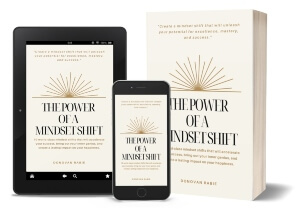Welcome to our comprehensive guide on mindfulness for anxiety relief. In this article, we will explore the concept of mindfulness and its effectiveness in calming the anxious mind. By understanding anxiety and incorporating mindfulness practices into your daily routine, you can find greater peace, balance, and well-being.
In This Article
ToggleUnderstanding Anxiety
Anxiety is a common mental health condition that affects millions of people worldwide. It can manifest as persistent worrying, excessive fear, restlessness, and physical symptoms such as rapid heartbeat and shortness of breath. Living with anxiety can be overwhelming and impact various aspects of life, including work, relationships, and overall happiness.
10 world-class mindset shifts that will…
~ Accelerate your success.
~ Bring out your inner genius.
~ Create a lasting impact on your happiness.
Price From: $5.18
The Benefits of Mindfulness
Mindfulness is the practice of intentionally focusing one’s attention on the present moment without judgment. It involves cultivating awareness of the present experience, including thoughts, emotions, and bodily sensations. Numerous studies have shown that mindfulness can be highly beneficial for anxiety relief and overall mental well-being.
By practicing mindfulness, individuals develop the ability to observe their thoughts and emotions without becoming entangled in them. This non-reactive stance helps create a sense of space and freedom from the grip of anxiety. Mindfulness also promotes self-compassion and acceptance, allowing individuals to respond to their anxious thoughts and feelings with kindness and understanding.
Practical Mindfulness Techniques
There are several mindfulness techniques you can incorporate into your daily routine to alleviate anxiety. Let’s explore some of these practices:
1. Deep Breathing
Deep breathing is a simple yet powerful technique that helps activate the body’s relaxation response. Find a quiet and comfortable space to sit or lie down. Close your eyes and take a deep breath in through your nose, allowing your belly to expand. Then slowly exhale through your mouth, releasing any tension or stress. Repeat this process for several minutes, focusing your attention on the sensation of your breath.
2. Body Scan
The body scan is a practice that involves systematically bringing awareness to each part of the body. Lie down in a comfortable position and close your eyes. Begin by focusing on your toes, noticing any sensations or tension present. Gradually move your attention up through your feet, legs, torso, arms, and head, observing any physical sensations or areas of discomfort. By scanning your body with mindful awareness, you can release tension and promote relaxation.
3. Mindful Walking
Mindful walking is a technique that combines physical movement with present-moment awareness. Find a quiet outdoor space and start walking at a natural pace. As you walk, bring your attention to the sensation of your feet touching the ground, the movement of your body, and the surrounding environment. Notice the sights, sounds, and smells without judgment. Whenever your mind wanders, gently bring it back to the present moment and the act of walking.
4. Meditation
Meditation is a core mindfulness practice that involves sitting comfortably and focusing your attention on a chosen object, such as the breath, a sound, or a specific visualization. Start by finding a quiet space where you won’t be interrupted. Close your eyes, relax your body, and bring your attention to your chosen focal point. When thoughts or distractions arise, acknowledge them without judgment and gently return your focus to the chosen object. Regular meditation practice can enhance mindfulness and reduce anxiety over time.
Incorporating Mindfulness into Daily Life
To experience the full benefits of mindfulness, it’s important to integrate it into your daily life. Here are some practical ways to incorporate mindfulness into your routine:
Morning Ritual: Begin your day with a few minutes of deep breathing or a short meditation session to set a positive and grounded tone for the day ahead.
Mindful Eating: Pay attention to the taste, texture, and smell of your food during meals. Chew slowly and savor each bite, fully engaging your senses.
Digital Detox: Take regular breaks from technology to disconnect and be present in the moment. Engage in activities like reading, walking, or spending time in nature.
Gratitude Practice: Cultivate gratitude by reflecting on three things you are grateful for each day. This practice can shift your focus from anxiety to appreciation.
Mindful Communication: During conversations, give your full attention to the person speaking. Practice active listening and respond with empathy and understanding.
Bedtime Routine: Wind down before sleep with a guided relaxation or body scan practice. This can help calm your mind and promote a restful night’s sleep.
Conclusion
Incorporating mindfulness into your daily life can be a powerful tool for managing anxiety and finding inner calm. By cultivating awareness and practicing techniques like deep breathing, body scanning, mindful walking, and meditation, you can develop resilience in the face of anxiety-provoking situations. Remember to be patient and kind to yourself throughout this journey. With consistent practice, mindfulness can become a valuable skill for finding peace and relief from anxiety.







